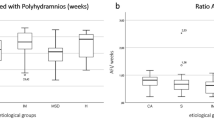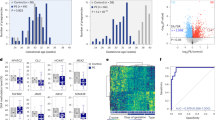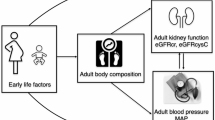Abstract
Meckel–Gruber Syndrome is a rare autosomal recessive lethal ciliopathy characterized by the triad of cystic renal dysplasia, occipital encephalocele and postaxial polydactyly. We present the largest population-based epidemiological study to date using data provided by the European Surveillance of Congenital Anomalies (EUROCAT) network. The study population consisted of 191 cases of MKS identified between January 1990 and December 2011 in 34 European registries. The mean prevalence was 2.6 per 100 000 births in a subset of registries with good ascertainment. The prevalence was stable over time, but regional differences were observed. There were 145 (75.9%) terminations of pregnancy after prenatal diagnosis, 13 (6.8%) fetal deaths, 33 (17.3%) live births. In addition to cystic kidneys (97.7%), encephalocele (83.8%) and polydactyly (87.3%), frequent features include other central nervous system anomalies (51.4%), fibrotic/cystic changes of the liver (65.5% of cases with post mortem examination) and orofacial clefts (31.8%). Various other anomalies were present in 64 (37%) patients. As nowadays most patients are detected very early in pregnancy when liver or kidney changes may not yet be developed or may be difficult to assess, none of the anomalies should be considered obligatory for the diagnosis. Most cases (90.2%) are diagnosed prenatally at 14.3±2.6 (range 11–36) gestational weeks and pregnancies are mainly terminated, reducing the number of LB to one-fifth of the total prevalence rate. Early diagnosis is important for timely counseling of affected couples regarding the option of pregnancy termination and prenatal genetic testing in future pregnancies.
Similar content being viewed by others
Log in or create a free account to read this content
Gain free access to this article, as well as selected content from this journal and more on nature.com
or
References
Meckel JF : Beschreibung zweier, durch sehr aehnliche Bildungsabweichungen entstellter Geschwister. Dtsch Arch Physiol 1822; 7: 99–172.
Opitz JM, Howe JJ : The Meckel syndrome (dysencephalia splanchnocystica, the Gruber Syndrome). Birth Defects 1969; 2: 167–179.
Mecke S, Passarge E : Encephalocele, polycystic kidneys, and polydactyly as an autosomal recessive trait simulating certain other disorders: the Meckel syndrome. Ann Genet 1971; 14: 97–103.
Hsia YE, Bratu M, Herbordt A : Genetics of the Meckel syndrome (dysencephalia splanchnocystica). Pediatrics 1971; 48: 237–247.
Fraser FC, Lytwyn A : Spectrum of anomalies in the Meckel syndrome, or: "Maybe there is a malformation syndrome with at least one constant anomaly". Am J Med Genet 1981; 9: 67–73.
Salonen R : The Meckel syndrome: clinicopathological findings in 67 patients. Am J Med Genet 1984; 18: 671–689.
Alexiev BA, Lin X, Sun CC, Brenner DS : Meckel-Gruber Syndrome: pathologic manifestations, minimal diagnostic criteria, and differential diagnosis. Arch Pathol Lab Med 2006; 130: 1236–1238.
Young ID, Rickett AB, Clerke M : High incidence of Meckel's syndrome in Gujarati Indians. J Med Genet 1985; 22: 301–304.
Seller MJ : Meckel syndrome and the prenatal diagnosis of neural tube defects. J Med Genet 1978; 15: 462–465.
Panduranga C, Kangle R, Badami R, Patil PV : Meckel-Gruber Syndrome: report of two cases. J Neurosci Rural Pract 2012; 3: 56–59.
Crawfurd Md'A, Jackson P, Kohler HG : Meckel's syndrome (dysencephalia splanchno-cystica) in two Pakistani sibs. J Med Genet 1978; 15: 242–245.
Farag TI, Usha R, Uma R, Mady SA, al-Nagdy K, el-Badramany MH : Phenotypic variability in Meckel-Gruber Syndrome. Clin Genet 1990; 38: 176–179.
Teebi AS, Al Saleh QA, Odeh H : Meckel syndrome and neural tube defects in Kuwait. J Med Genet 1992; 29: 140.
Moerman P, Verbeken E, Fryns JP, Goddeeris P, Lauwcryns JM : The Meckel syndrome. Pathological and cytogenetic observations in eight cases. Hum Genet 1982; 62: 240–245.
Salonen R, Norio R : The Meckel syndrome in Finland: epidemiologic and genetic aspects. Am J Med Genet 1984; 18: 691–698.
Shaheen R, Shamseldin HE, Loucks CM et al: Mutations in CSPP1, encoding a core centrosomal protein, cause a change of ciliopathy phenotypes in humans. Am J Hum Genet 2014; 94: 73–79.
Aguilar A, Meunier A, Strehl L et al: Analysis of human samples reveals impaired SHH-dependent cerebellar development in Joubert syndrome/Meckel syndrome. Proc Natl Acad Sci USA 2012; 109: 16951–16956.
Shaheen R, Ansari S, Mardawi EA, Alshammari MJ, Alkuraya FS : Mutations in TMEM231 cause Meckel-Gruber Syndrome. J Med Genet 2013; 50: 160–162.
Abdelhamed ZA, Wheway G, Szymanska K et al: Variable expressivity of ciliopathy neurological phenotypes that encompass Meckel-Gruber Syndrome and Joubert syndrome is caused by complex de-regulated ciliogenesis, Shh and Wnt signalling defects. Hum Mol Genet 2013; 22: 1358–1372.
Barker AR, Thomas R, Dawe HR : Meckel-Gruber Syndrome and the role of primary cilia in kidney, skeleton and central nervous system development. Organogenesis 2013; 10: 96–107.
Lowry RB, Hill RH, Tischler B : Survival and spectrum of anomalies in the Meckel syndrome. Am J Med Genet 1983; 14: 417–421.
Wright C, Healicon R, English C, Burn J : Meckel syndrome: what are the minimum diagnostic criteria? J Med Genet 1994; 31: 482–485.
Ickowicz V, Eurin D, Maugey-Laulom B et al: Meckel-Gruber Syndrome: sonography and pathology. Ultrasound Obstet Gynecol 2006; 27: 296–300.
Eckmann-Scholz C, Jonat W, Zerres K, Ortiz-Brüchle N : Earliest ultrasound findings and description of splicing mutations in Meckel-Gruber Syndrome. Arch Gynecol Obstet 2012; 286: 917–921.
EUROCAT website. Available at http://www.eurocat-network.eu/.
EUROCAT ‘Guide 1.3’. Available at http://www.eurocat-network.eu/ABOUTES/DataCollection/GuidelinesforRegistration/Guide1_3InstructionManual.
EUROCAT 'Members & Registry Descriptions'. Available at http://www.eurocat-network.eu/ABOUTES/MemberRegistries/MembersAndRegistryDescriptions/AllMembers.
Barisic I, Tokic V, Loane M et al: Descriptive epidemiology of Cornelia de Lange syndrome in Europe. Am J Med Genet 2008; 146: 51–59.
Boyle B, McConkey R, Garne E et al: Trends in the prevalence, risk and pregnancy outcome of multiple births with congenital anomaly: a registry-based study in 14 European countries 1984-2007. BJOG 2013; 120: 707–716.
Shozu M, Akimoto K, Tanaka J, Sonoda Y, Inoue M, Michikura Y : Antenatal detection of Meckel-Gruber Syndrome in only one dizygotic twin following in vitro fertilization and embryo transfer. Gynecol Obstet Invest 1997; 43: 142–144.
Celentano C, Prefumo F, Liberati M, Gallo G, Di Nisio Q, Rotmensch S : Prenatal diagnosis of Meckel-Gruber Syndrome in a pregnancy obtained with ICSI. JAssist Reprod Genet 2006; 23: 281–283.
de Mouzon J, Goossens V, Bhattacharya S et al: Assisted reproductive technology in Europe, 2007: results generated from European registers by ESHRE. Hum Reprod 2012; 27: 954–966.
Ramadani HM, Nasrat HA : Prenatal diagnosis of recurrent Meckel syndrome. Int J Gynaecol Obstet 1992; 39: 327–332.
Parelkar SV, Kapadnis SP, Sanghvi BV, Joshi PB, Mundada D, Oak SN : Meckel-Gruber Syndrome: a are and lethal anomaly with review of literature. J Pediatr Neurosci 2013; 8: 154–157.
Paavola P, Salonen R, Baumer A et al: Clinical and genetic heterogeneity in Meckel syndrome. Hum Genet 1997; 101: 88–92.
Szymanska K, Berry I, Logan CV et al: Founder mutations and genotype-phenotype correlations in Meckel-Gruber Syndrome and associated ciliopathies. Cilia 2012; 1: 18.
Khaddour R, Smith U, Baala L et al: Spectrum of MKS1 and MKS3 mutations in Meckel syndrome: a genotype-phenotype correlation. Mutation in brief #960. Online. Hum Mutat 2007; 28: 523–524.
Sepulveda W, Sebire NJ, Souka A, Snijders RJ, Nicolaides KH : Diagnosis of the Meckel-Gruber Syndrome at eleven to fourteen weeks’ gestation. Am J Obstet Gynecol 1997; 176: 316–319.
Behairy NH, Talaat S, Saleem SN, El-Raouf MA : Magnetic resonance imaging in fetal anomalies: what does it add to 3D and 4D US? Eur J Radio 2010; 74: 250–255.
Acknowledgements
This study is a part of the EUROCAT Joint Action funded by the EC, under the framework of EU Health Programme 2008–2013, Grant Agreement 20102204 (Executive Agency for Health & Consumers). We thank doctors Larraitz Arriola, Sebastiano Bianca, Jean Chapple, Berenice Doray, Christine Francannet, Miriam Gatt, Anna Latos-Bielenska, Bob McDonnell, Carmen Mosquera-Tenreiro, Vera Nelen, Mary O'Mahony, Catherine Rounding, Joaquin Salvador, Gioacchino Scarano, David Stone, Romano Tenconi, David Tucker, for providing data for the present study. We also thank the many people throughout Europe involved in providing and processing information, including affected families, clinicians, health professionals, medical record clerks, and registry staff.
Author information
Authors and Affiliations
Corresponding author
Ethics declarations
Competing interests
The authors declare no conflict of interest.
Rights and permissions
About this article
Cite this article
Barisic, I., Boban, L., Loane, M. et al. Meckel–Gruber Syndrome: a population-based study on prevalence, prenatal diagnosis, clinical features, and survival in Europe. Eur J Hum Genet 23, 746–752 (2015). https://doi.org/10.1038/ejhg.2014.174
Received:
Revised:
Accepted:
Published:
Issue date:
DOI: https://doi.org/10.1038/ejhg.2014.174
This article is cited by
-
Neurosurgical intervention for the Meckel-Gruber Syndrome: A systematic review
Child's Nervous System (2024)
-
Fetal ciliopathies: a retrospective observational single-center study
Archives of Gynecology and Obstetrics (2022)
-
Prenatal ultrasound in fetuses with polycystic kidney appearance — expanding the diagnostic algorithm
Archives of Gynecology and Obstetrics (2022)
-
Two novel TCTN2 mutations cause Meckel–Gruber syndrome
Journal of Human Genetics (2020)
-
Imaging of fetal cystic kidney disease: multicystic dysplastic kidney versus renal cystic dysplasia
Pediatric Radiology (2020)



